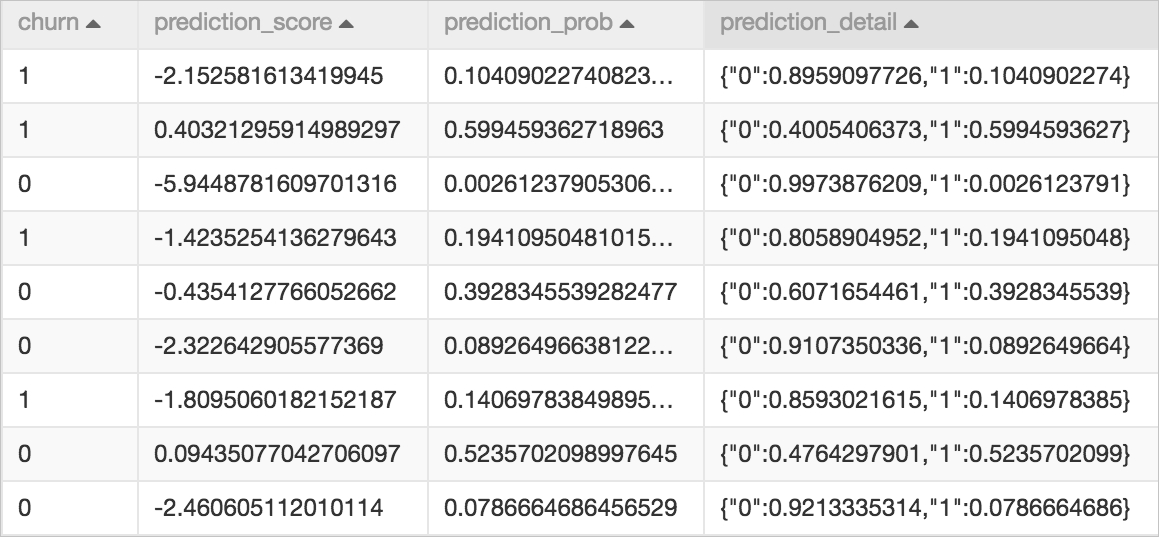The Scorecard Prediction component uses the model that is generated by the Scorecard Training component to predict scores.
Configure the component
You can use one of the following methods to configure the Scorecard Prediction component.
Method 1: Configure the component on the pipeline page
You can configure the parameters of the Scorecard Prediction component on the pipeline page of Machine Learning Designer of Machine Learning Platform for AI (PAI). Machine Learning Designer is formerly known as Machine Learning Studio. The following table describes the parameters.
| Tab | Parameter | Description |
|---|---|---|
| Fields Setting | Feature Columns | The feature columns that are used in prediction. By default, all feature columns are selected. |
| Reserved Columns | The columns that are appended to the prediction result table without processing, such as the ID and objective columns. | |
| Output Variable Score | Specifies whether to generate a score for each feature variable. The total predicted score is the score of intercept options plus the score of each variable. | |
| Tuning | Cores | The number of CPU cores that are required. By default, the system determines the value. |
| Memory Size per Core | The memory size of each CPU core. By default, the system determines the value. |
Method 2: Use PAI commands
Configure the component parameters by using PAI commands. You can use the SQL Script component to call PAI commands. For more information, see SQL Script.
pai -name=lm_predict
-project=algo_public
-DinputFeatureTableName=input_data_table
-DinputModelTableName=input_model_table
-DmetaColNames=sample_key,label
-DfeatureColNames=fea1,fea2
-DoutputTableName=output_score_table| Parameter | Description | Required | Default value |
|---|---|---|---|
| inputFeatureTableName | The name of the input feature table. | Yes | No default value |
| inputFeatureTablePartitions | The partitions that are selected from the input feature table. | No | Full table |
| inputModelTableName | The name of the input model table. | Yes | No default value |
| featureColNames | The feature columns that are selected from the input table. | No | All columns |
| metaColNames | The columns that do not need to be converted. These columns in the output are the same as those in the input. You can specify labels and sample IDs in the columns. | No | No default value |
| outputFeatureScore | Specifies whether to generate the scores of variables in the prediction results. Valid values:
| No | false |
| outputTableName | The name of the output table. | Yes | No default value |
| lifecycle | The lifecycle of the output table. | No | No default value |
| coreNum | The number of cores. | No | Determined by the system |
| memSizePerCore | The memory size of each core. Unit: MB. | No | Determined by the system |
Output
The following figure shows a score table generated by the Scorecard Prediction component.  The churn column is the column appended to the result table from the input table. The data in this column does not affect the prediction results. The other three columns display the prediction results. The following table describes the three columns.
The churn column is the column appended to the result table from the input table. The data in this column does not affect the prediction results. The other three columns display the prediction results. The following table describes the three columns.
 The churn column is the column appended to the result table from the input table. The data in this column does not affect the prediction results. The other three columns display the prediction results. The following table describes the three columns.
The churn column is the column appended to the result table from the input table. The data in this column does not affect the prediction results. The other three columns display the prediction results. The following table describes the three columns. | Column | Data type | Description |
|---|---|---|
| prediction_score | DOUBLE | The column that contains predicted scores. In a linear model, the feature values and model weight values are multiplied and summed up to obtain the predicted scores. In a scorecard model, if score transformation is performed, the transformed scores are generated in this column. |
| prediction_prob | DOUBLE | The column that contains the probability values of positive samples in binary classification. The probability values are transformed from the original scores (without score transformation) by using the sigmoid function. |
| prediction_detail | STRING | The column that contains the probability values of positive and negative samples described in JSON strings. The value 0 represents negative, and the value 1 represents positive. Example: {"0":0.1813110520,"1":0.8186889480}. |